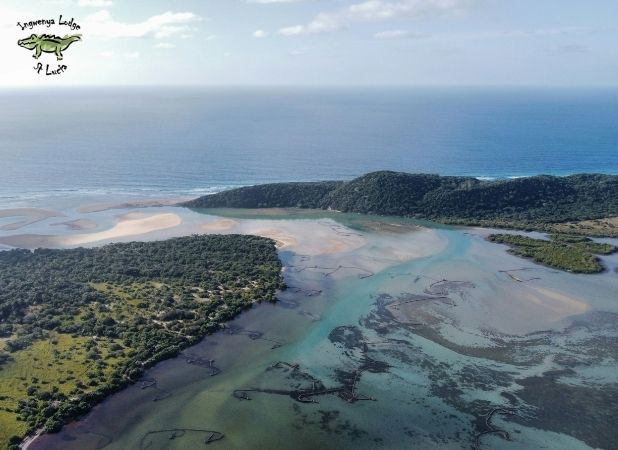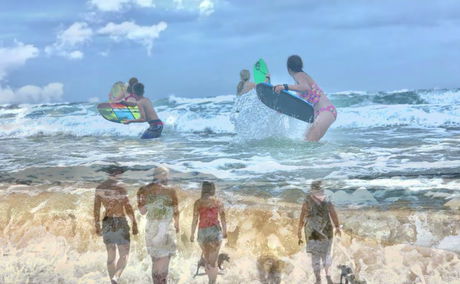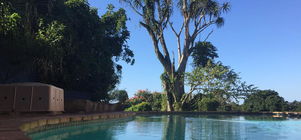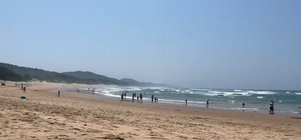December in St Lucia is full for a reason. Families travel from all over South Africa, cars line the streets, and every beach day feels like a shared event. It's festive, busy, and for many people, exactly what they want. But once the Christmas rush fades, something else happens. January arrives quietly – and St Lucia changes pace. The same warm ocean. The same green summer landscape. The same wildlife moving through...
Kosi Bay Mouth – Where Estuary, Ocean and Culture Collide

Kosi Bay Mouth is the kind of place that makes you slow down without even realising it. It sits in the far northern reaches of the iSimangaliso Wetland Park – a UNESCO World Heritage Site that begins down in St Lucia – and it feels worlds apart. The journey there takes about two and a half hours, carrying you past open grassland and rural homesteads before the road starts to twist through the coastal forest.
The mouth itself is a meeting point – of estuary and ocean, of clear tidal waters and the deep blue beyond, of natural rhythms and a way of life that has carried on for centuries. Four lakes feed into this estuary, and on a still day you can see the patterns of the current as it drifts around the ancient wooden fish traps set by the Thonga people. You don’t come here for a checklist of activities. You come to walk through the shallows, to watch fish dart around your feet, to listen to local guides explaining how these traps work and why they matter. It’s a day with no fences and no crowds – just space, water and time.
Why Kosi Bay Mouth Is Unique
There are few places in South Africa where you can stand in one spot and see so many worlds overlap. At Kosi Bay Mouth, the estuary pours into the Indian Ocean, and the four lakes behind it stretch inland like a quiet, hidden system of waterways. It is a landscape that feels untouched – still ruled by tides and seasons rather than people. What makes it even more remarkable is the way culture and nature sit side by side. The curved wooden fish traps, built and maintained by the local Thonga people, have been part of this place for centuries. Guided walks to these traps aren’t just a look at how fish are caught – they are lessons in how people have learned to work with water rather than against it. A few kilometres inland, Lake Sibaya forms part of the same northern section of the iSimangaliso Wetland Park. Taken together, these waters create a sanctuary for fish, birds and the people who depend on them. It’s a slower, more timeless side of KwaZulu-Natal – a long way from the bustle of St Lucia, yet still connected to it.
What You’ll See and Do
A day at Kosi Bay Mouth is never rushed. There isn’t a schedule here – just a handful of experiences that unfold as you step into the water and explore. Local guides often begin with a walk out to the wooden fish traps, explaining how the tide works with the curved channels to guide fish in. It’s as much a cultural encounter as it is a lesson in sustainability, and you’ll leave with a deeper respect for the people who live here. The mouth itself is shallow and clear – a calm, natural pool where you can drift with a mask and see shoals of small fish moving around your feet. It’s one of the gentlest places to try estuary snorkelling in KwaZulu-Natal, with no waves or currents to fight. If you’ve enjoyed the open-water reefs of Sodwana Bay, this is a quieter, more beginner-friendly alternative. Back on the shore, birdwatchers are in their element. Bee-eaters flash colour as they skim low over the sand, kingfishers watch from the mangroves, and waders pick their way across the shallows. Even when you’re not looking for anything in particular, there’s always something happening in the space between the dunes and the water.
How to Get There from St Lucia
From St Lucia it’s about 165 kilometres to Kosi Bay Mouth – roughly two and a half hours by car. The route takes you north along the same coastal corridor that links many of the wildest parts of the iSimangaliso Wetland Park. The first part of the drive is straightforward, through open countryside and small Zululand villages. As you get closer, the landscape changes – the air gets saltier, the forest thickens, and the road narrows. For the last stretch a 4x4 is essential. These sandy tracks eventually lead you to a parking area, and from there the rest of the way is usually on foot, guided by locals who know the tides and channels well. It’s best to plan this as a full-day trip. Leave early, give yourself time to explore the mouth, and enjoy the drive back as the day cools.
Insider Tips for Your Day Trip
A visit to Kosi Bay Mouth works best when you keep things simple. Wear shoes you don’t mind getting wet – most of the exploring happens in ankle‑deep water, and you’ll spend a good part of the day walking and wading. The experience is shaped by the tide. Low tide is best for seeing the wooden fish traps clearly and for gentle snorkelling in the shallows. Local guides can time your visit so you get the most out of the day – and while many guides are community‑based, it’s always a good idea to carry some cash as there are no card facilities here. Pack enough drinking water and snacks. There are no shops near the mouth, so everything you need should come with you. If you leave early, you can easily add a stop at Lake Sibaya to your day – it’s on the way up, and the stillness of the lake is a lovely counterpoint to the tidal waters of Kosi Bay. Above all, remember that this is more than just a Kosi Bay Mouth day trip. It’s a cultural encounter. Ask before you take photos at the fish traps and take time to listen to the stories – they’re part of what makes this part of the iSimangaliso coast so unforgettable.
Plan Your Day and Make It Yours
A day at Kosi Bay Mouth is unlike any other along this coastline. It’s quieter, more remote, and it lingers with you long after you’ve dried your feet. It’s a place where the tide sets the pace and where every hour feels unhurried – whether you spend it wading among the fish traps, snorkelling in the shallows or simply sitting back to watch the estuary and ocean meet. It pairs perfectly with the other northern stops in our guide to the 10 Best Day Trips from St Lucia. You can spend one day here, another at Lake Sibaya or Sodwana Bay, and balance it all out with a bush safari in Hluhluwe-iMfolozi Park. Base yourself at Ingwenya Lodge and you’ll be close enough to reach these wild places – and far enough from the noise to come home to quiet at the end of each day.
Further Reading
Evenings in St Lucia have a certain rhythm. The air is warm, the sea hums just beyond the estuary, and somewhere along the coast, the first leatherback turtle hauls herself out of the surf. From the deck at Ingwenya Lodge, guests often watch the sky darken and know that, down the beach, one of the ocean’s oldest rituals is beginning.
Ingwenya Lodge is a family-run self-catering lodge on the outskirts of St Lucia, nestled against the iSimangaliso Wetland Park (South Africa's first UNESCO World Heritage Site). The lodge's six units each have fully equipped kitchens and modern comforts, and the property offers panoramic views of both the St Lucia estuary and the Indian Ocean. The setting is tranquil – hippos often graze on the lawns at night – giving guests a genuine...







Share This Post